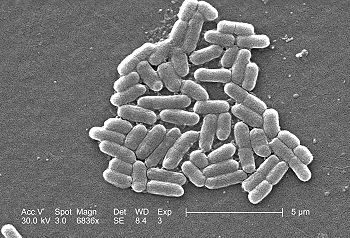Escherichia coli: Difference between revisions
imported>Robert Badgett No edit summary |
imported>Howard C. Berkowitz No edit summary |
||
| Line 4: | Line 4: | ||
'''''Escherichia coli''''' (commonly known as ''E. coli''), is one of the main species of [[bacteria]] living in the lower intestines of mammals, known as gut flora. When located in the large instestine, it assists with waste processing, vitamin K production, and food absorption. Discovered in 1885 by Theodor Escherich, a German pediatrician and bacteriologist, ''E. coli'' are abundant: the number of individual ''E. coli'' bacteria in the feces that a human defecates in one day averages between 100 billion and 10 trillion. However, the bacteria are not confined to this environment, and specimens have also been located, for example, on the edge of hot springs. | '''''Escherichia coli''''' (commonly known as ''E. coli''), is one of the main species of [[bacteria]] living in the lower intestines of mammals, known as gut flora. When located in the large instestine, it assists with waste processing, vitamin K production, and food absorption. Discovered in 1885 by Theodor Escherich, a German pediatrician and bacteriologist, ''E. coli'' are abundant: the number of individual ''E. coli'' bacteria in the feces that a human defecates in one day averages between 100 billion and 10 trillion. However, the bacteria are not confined to this environment, and specimens have also been located, for example, on the edge of hot springs. | ||
==Serotype O157== | |||
''Escherichia coli O157'' is a "verocytotoxin-producing serogroup belonging to the O subfamily of Escherichia coli which has been shown to cause severe food-borne disease. A strain from this serogroup, serotype H7, which produces shiga toxins, has been linked to human disease outbreaks resulting from contamination of foods by E. coli O157 from bovine origin."<ref>{{MeSH|Escherichia coli O157}}</ref><ref name="pmid3056169">{{cite journal |author=Griffin PM, Ostroff SM, Tauxe RV, ''et al'' |title=Illnesses associated with Escherichia coli O157:H7 infections. A broad clinical spectrum |journal=Ann. Intern. Med. |volume=109 |issue=9 |pages=705–12 |year=1988 |month=November |pmid=3056169 |doi= |url= |issn=}}</ref> | ''Escherichia coli O157'' is a "verocytotoxin-producing serogroup belonging to the O subfamily of Escherichia coli which has been shown to cause severe food-borne disease. A strain from this serogroup, serotype H7, which produces shiga toxins, has been linked to human disease outbreaks resulting from contamination of foods by E. coli O157 from bovine origin."<ref>{{MeSH|Escherichia coli O157}}</ref><ref name="pmid3056169">{{cite journal |author=Griffin PM, Ostroff SM, Tauxe RV, ''et al'' |title=Illnesses associated with Escherichia coli O157:H7 infections. A broad clinical spectrum |journal=Ann. Intern. Med. |volume=109 |issue=9 |pages=705–12 |year=1988 |month=November |pmid=3056169 |doi= |url= |issn=}}</ref> | ||
Food infections from this type have frequently propagated through industrially prepared ground beef. Contamination of a grinder has contaminated thousands of pounds, which were then packaged and sent to fast food restaurants. | |||
==References== | ==References== | ||
<references/> | <references/> | ||
Revision as of 22:21, 20 May 2009
Escherichia coli (commonly known as E. coli), is one of the main species of bacteria living in the lower intestines of mammals, known as gut flora. When located in the large instestine, it assists with waste processing, vitamin K production, and food absorption. Discovered in 1885 by Theodor Escherich, a German pediatrician and bacteriologist, E. coli are abundant: the number of individual E. coli bacteria in the feces that a human defecates in one day averages between 100 billion and 10 trillion. However, the bacteria are not confined to this environment, and specimens have also been located, for example, on the edge of hot springs.
Serotype O157
Escherichia coli O157 is a "verocytotoxin-producing serogroup belonging to the O subfamily of Escherichia coli which has been shown to cause severe food-borne disease. A strain from this serogroup, serotype H7, which produces shiga toxins, has been linked to human disease outbreaks resulting from contamination of foods by E. coli O157 from bovine origin."[1][2]
Food infections from this type have frequently propagated through industrially prepared ground beef. Contamination of a grinder has contaminated thousands of pounds, which were then packaged and sent to fast food restaurants.
References
- ↑ Anonymous (2024), Escherichia coli O157 (English). Medical Subject Headings. U.S. National Library of Medicine.
- ↑ Griffin PM, Ostroff SM, Tauxe RV, et al (November 1988). "Illnesses associated with Escherichia coli O157:H7 infections. A broad clinical spectrum". Ann. Intern. Med. 109 (9): 705–12. PMID 3056169. [e]
